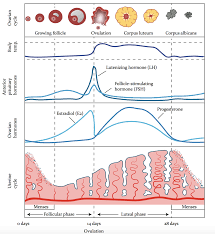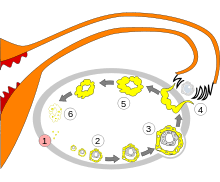The reproductive cycle in the female primates (e.g. monkeys, apes and human beings) is called menstrual cycle. The first menstruation begins at puberty and is called menarche. In human females, menstruation is repeated at an average interval of about 28/29 days, and the cycle of events from one menstruation till next is called the menstrual cycle. One ovum is released (ovulation) 14 days before the first day of start of menstruation i.e during the middle of each menstrual cycle of 28 days.

Phases of menstrual cycle:-
(i) Menstrual phase:- Menstrual flow occurs in this phase and it lasts for 3 to 4 days. This flow results due to the breakdown of endometrial lining of the uterus and its blood vessels which form a liquid and flows out through the vagina. Menstruation usually occurs about 14 days after ovulation, if the released ovum is not fertilized. Lack of menstruation may be indicative of pregnancy.
The total amount of blood discharged in one cycle is 30 to 50 ml. This blood can form clots in the uterus. Later, fibrinolytic enzymes from the uterus dissolve the clots such that the menstrual blood remains in liquid state.
(ii) Follicular phase:- The menstrual phase is followed by the follicular phase. During this phase, primary follicles in ovary grow to become a fully mature Graafian follicle and simultaneously the endometrium of uterus regenerates through proliferation. These changes in the ovary and the uterus are reduced by changes in the levels of pituitary gonadotropins and ovarian hormones. Secretion of gonadotropins (LH and FSH) increases gradually during the follicular phase and stimulates. Follicular development and secretion of estrogens by the growing follicles. FSH stimulates follicular growth. The follicular cells secrete estrogen, a sex hormone that also aids in the growth of the follicle. Estrogen stimulates mitotic divisions of the cells in the lining of uterus and helps to repair the broken tissue and blood vessels. It also causes the thickening of the endometrium. Both FSH and LH attain a peak level on the 14th day of 28th day cycle. During this phase, the estrogen level in blood continues to rise until it reaches the peak and the Graafian follicle moves to the surface of ovary. The elevated estrogen levels act by positive feedback mechanism and stimulate the anterior lobe of pituitary to secrete luteinizing (LH) hormone which initiates the next stage of menstrual cycle.
Rapid secretion of LH leading to its maximum level during the mid-cycle is called the LH surge which induces the rupture of Graafian follicle thereby resulting in release of ovum (ovulation).
Series of events occurring in the ovary during menstrual cycle Is called the ovulation cycle The ovarian cycle is regulated by hormones produced by hypothalamus and pituitary.
(iii) Ovulation:- LH induces ovulationwhich usually occurs on 14th day in the 28 days cycle. The graafian follicle ruptures and secondary oocyte (ovum) is released. If fertilization does not occur, menstruation occurs 14 days after ovulation.
Day of ovulation = Number of days in M cycle – 14
|
(iv) Luteal/Secretory phase:- Following ovulation, an egg is swept into the fallopian tube, where it awaits fertilization as it travels through the tube towards uterus. The egg has stored nutrients to survive about 24 hours. The ovulatory phase is followed by luteal pahse during which the remaining parts of Graafian follicle transform into Corpus luteum in the ovary.

Corpus luteum (Yellow body) secretes large amount of progesterone which is essential for maintenance of endometrium which is thickened by estrogen. In luteal phase, the endometrium further thickens due to estrogen also secreted by corpus luteum. LH causes the cells of the ruptured follicle to form corpus luteum. Corpus luteum is a yellowish mass of follicular cells that function like an endocrine structure and also stimulates the corpus luteum to secrete estrogen and progesterone. Estrogen and progesterone inhibits the release of FSH and LH. This prevents the development of new follicles during the luteal phase. Luteal phase lasts for 14 days. During this phase, the level of estrogen and progesterone will rise, while FSH and LH levels drop. Low level of LH causes, degeneration of corpus luteum leading to a sudden decline in progesterone level that causes menstruation.
Maintenance of endometrium by progesterone is necessary for implantation of the fertilized ovum and maintenance of pregnancy. During pregnancy, all the events of the menstrual cycle stop and there is no menstruation due to high level of progesterone.
In the absence of fertilization, the corpus luteum degenerates into corpus albicans as the level of progesterone will fall. This causes disintegration of the endometrium leading to menstruation, marking a new cycle. Inhuman beings, menstrual cycles ceases around 50 years of age, termed as menopause. Cyclic menstruation is an indicator of normal reproductive phase and extends between menarche and menopause.
Note:-
Menstrual Hygiene
Maintenance of hygiene and sanitation during menstruation is very important. Take bath and clean yourself regularly. Use sanitary napkins or clean homemade pads. Change sanitary napkins or homemade pads after every 4-5 hrs as per the requirement. Dispose of the used sanitary napkins properly wrapping it with a used paper. Do not throw the used napkins in the drainpipe of toilets or in the open area. After handling the napkin wash hands with soap.

The estrous cycle consists of cyclic changes in the female reproductive system of non-primate mammals. There is no menstruation at the end of estrous cycle. The estrogen level in blood increases resulting in a strong sex urge in the female. This is called “period of heat”. The estrous cycles run only during breeding season. The estrous cycles remain suspended in female during non-breeding season. The suspension of estrous cycle is called anestrum. The animals that have only a single estrous cycle during the breeding season are called monoestrous, e.g., fox deer, bat etc. and animals that a recurrence of estrous cycles during breeding season are called polyestrous, e.g., Mouse, squirrel, cow, sheep, pig, horse etc.